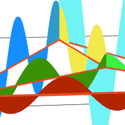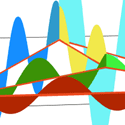Equality for quantum graphs
A quantum graph consists of a set of vertices and edges that can model a variety of systems such as electronic bonds in a complex molecule, a network of quantum wires, and photonic crystals. A wave function distributed over such a graph can be localized, in which case it is concentrated within a certain region; or, at the opposite extreme, it can spread itself equally over all possible regions.
Writing in Physical Review Letters, Sven Gnutzmann of the University of Nottingham and Jon Keating and Fabien Piotet of the University of Bristol use methods from field theory to provide a measure of how close a large quantum graph is to having a wave function uniformly spread over all its vertices and how quickly this happens.
In their model, the probability for a particle to move along the edges is determined by a quantum mechanical scattering matrix at each vertex and is analogous to a classical graph in which a memoryless (Markov) process describes the transition probabilities. So, what is the criterion for determining whether the wave function is distributed equally over the entire quantum graph? The answer depends on how the eigenvalue spectrum for the corresponding classical graph changes as the graph size is increased. Such semiclassical approximations and analogies provide a bridge between the quantum and classical worlds. – Sonja Grondalski





